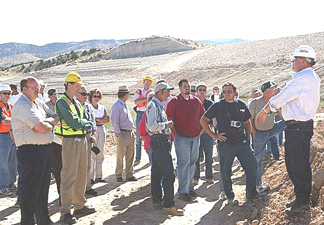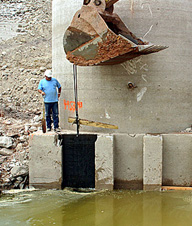Utah Water User’s Association President Profile
Clyde Bunker leads Utah’s water organization during time of drought.
LeRoy W. Hooton, Jr.
November 10, 2003
|
The fate of Utah’s farmlands is closely following national trends. In a February 19, 2001 Deseret News article entitled, "Is Utah Losing Croplands?" the loss of Utah farmlands was noted, "Between 1892 and 1997, Utah's total cropland dipped from 2.03 million acres to 1.67 million … and cultivated cropland dropped 45 percent, from 1.29 million acres in 1982 to 705,000 acres in 1997 – the fourth largest drop in the nation."
As the issues of disappearing farmlands and drought besiege Utah’s water users, third generation Delta, Utah, farmer Clyde Bunker has led the Utah Water Users Association membership through this difficult period of Utah’s history. Not since the drought of the 1930’s have water issues dominated the daily lives of Utah residents. “In some ways the drought has been a good thing as it has made people more aware of how they use water,” exclaimed Bunker in a recent interview. Looking on the bright side of the drought, he noted, “…we have used less water per person this year … we need to carry what we have learned into the future when the drought is only a memory.”
During his tenure as president of the statewide water organization, water awareness has peaked. Issues including new water development funding, water conservation and water transfers from agriculture to municipal use have vexed both government and water leaders.
As to the latter, there is a subtle conflict between urban and rural water users competing for the state’s limited water resources. According to the Utah Foundation, agriculture consumes 85 percent of the state’s water resources. However, it’s the growing urban areas that are driving the need for new municipal & industrial water supplies. There is no sign that Utah’s population growth is about to abate and the transfer of water from one use to another use will continue as agricultural land is urbanized. Bunker understands the dilemma and the necessity to meet both agriculture and urban water needs if the state is to successfully grow and prosper. He believes that balance is necessary. “New water supplies for drinking, bathing, flushing toilets and household uses are needed for our grandchildren living in St. George to the Wasatch Front ... if we all work together, we can find a middle ground where we can all enjoy our lifestyles, even though we may all be required to make some adjustments,” said Bunker.
During the 2003 legislative session three separate committees studied the issue of financing water development. Governor Leavitt pushed to eliminate sales tax support for water development and instead fund it through water rates paid by municipal water users. On the other hand, the legislature and the water community favored the current sales tax revenue source. Ultimately, the decision was made to keep the sales tax revenue, however, the battle is probably not over. Nevertheless, it’s an issue that needs to be permanently resolved, exclaims Bunker, “We cannot afford to wait until a water crisis exists … that’s why money well spent today can likely ward off future crisis.”
|
The source of water for these storage facilities is the Sevier River and the current water supply outlook doesn’t look good for Bunker and the water users in the Sevier Basin. At the end of the 2003 water year, water flowing in the Sevier River basin was recorded as the lowest in the state. Reservoir storage is nearly depleted with only 2 percent of capacity remaining in the drainage reservoirs on October 1. According to Randy Julander, U.S. Natural Conservation Office snow supervisor, "The Sevier watershed is now in a state where [the water users] will be limited to actual streamflow plus whatever they can store between now and snowmelt runoff, which will be very little." After dam repairs, the 236,000 acre-foot Sevier Bridge Reservoir (Yuba Dam) has only 500 acre-feet of water in storage going into the new water year.
In an effort to protect his farming operation from drought, developing additional water resources has been necessary. “The cost of owning water rights for agriculture continues to rise,” avers Bunker. “In the past 10 years we have purchased well rights and drilled an irrigation well to supplement our surface rights … we live in a desert and without water, we all know what our farms would look like.”
Another aspect of agriculture is the habitat developed for the state’s wildlife and the use of reservoirs for recreational enjoyment. Bunker is passionate about this subject. He doesn’t believe that the agriculture community gets enough credit for these quality of life benefits. At every opportunity he makes the point that the state’s environment is much better off because of the ancillary benefits of water and habitat developments created by agricultural enterprises.
Bunker is an exporter of agricultural products, cubing his hay for exportation to Japan. With pride he eludes to the World Forage Super Bowl held in Madison WI, when in 1992 the quality of his hay earned him a “World Champion Hay Producer.” However, he notes that the market is changing. Some of his hay is still exported, but now he bales most of his hay and sends it to a dairy in Fresno, California. “More and more our livelihood depends on marketing our products,” notes Bunker.
Bunker wants his boys to continue the farming tradition when they complete their college educations. The question is will they survive the odds and not be counted among the numbers of declining farmers in the United States. “A decision will have to be made today or in the very near future, whether or not to protect agriculture food production, open spaces, wildlife habitat, or just have more asphalt parking lots,” warns Bunker.
When asked what our greatest challenge is, he replied, “To see that we manage our valuable water resources wisely, so that we leave the same legacy that our forefathers left us.”

